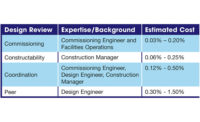Reviewing contractors’ equipment submittals has been a staple of the commissioning process since the beginning of building systems commissioning. Even the USGBC requires the Commissioning Authority (CA) to review contractor submittals in order to earn the Enhanced Commissioning credit in its LEED® certification program. What is a commissioning submittal review all about?
What It Is
The USGBC wants the submittals applicable to the commissioned systems to be reviewed for compliance with the owner’s project requirements (OPR) and basis of design (BOD). Assuming that the OPR and BOD are appropriately represented in the final construction documents (confirmed through design phase commissioning reviews), the required submittal review would be a comparison of the proposed equipment against the requirements of the contract documents. Is this any different from a review by the design engineers? Is a commissioning submittal review simply a second set of eyes? Many people want to know why two parties should be looking at the same documents, especially facility owners who don’t want to pay for the same work twice.I believe, based on my experience, that design engineers review the contractors’ submittals for compliance with the detailed requirements of the equipment schedules and specification, (size, capacity, materials, construction, ratings, etc). With few exceptions, this is a straightforward component-by-component review of the proposed equipment to be installed on a project. If the facility owner wants a redundant review of these items by the CA, it is no problem to provide one.
What It Should Be
However, the main focus of a commissioning review should be to go beyond the design engineers’ equipment-level review to look at system-wide operational considerations. Digging deeper into the LEED process documentation, the USGBC also suggests reviewing the submittals for “operation and maintenance requirements” and for “facilitating performance testing.” This is where we get into the meaningful substance of a commissioning review.The CA needs to look at how the individual pieces of equipment fit into their systems and communicate/interact with other components in the same systems. For example, a gas-fired steam generator for humidification may be the correct type and have the right capacity, but is it equipped with the controls hardware and software required to communicate with the BAS? I have seen humidifiers submitted that will work perfectly well as standalone devices - complete with all of their own control sensors, safeties, and programming - but, as designed, the humidifiers are intended to be controlled on/off and have setpoint adjustment by the external BAS.
This is where the CA’s systems approach is so valuable. Chances are fairly good that the humidifier submittal was compiled from the humidifier equipment specification section only without referencing other specification sections - such as controls - that define how the humidifier is to be integrated into the overall air-handling system. Even if there is a reference to the controls specification section in the equipment section, it is often missed by or not available to the person preparing the submittal. By identifying this disconnect early - i.e., during the submittal review process - commissioning can help avoid discovering the problem months later when the contractor tries to start-up and put the system into operation.
Another timing issue is the fact that the equipment submittals necessarily precede the controls submittal by weeks or months. There is a risk, therefore, of equipment being selected, approved, and ordered without it being coordinated and configured to work with the automation system. The CA has an opportunity to raise controls integration questions during the equipment review process, engaging, as needed, the controls contractor in helping to define what the equipment manufacturer needs to provide and not provide.
This level of review will come naturally if the CA approaches the contractors’ submittals with the goal of understanding all aspects of the systems to be commissioned in preparation for writing detailed functional performance test procedures. The question, “How will I test this in the field,” should be at the forefront of the CA’s mind when performing submittal reviews.
Enhanced Value
The CA should also look for ongoing maintenance concerns associated with the submitted equipment. This is especially true for equipment that is proposed as a substitute for what the design engineers specified. Granted, there is often very little, if any, maintenance information provided along with the equipment sizing and performance ratings during the submittal review process. As such, there is very little overt information to review. However, the CA should offer an understanding of subtle maintenance issues associated with various types or brands of the same equipment.In summary, the intent of a commissioning submittal review is to enhance, and not duplicate, the review performed by the design engineers. Both parties are professionals with a job to do and should approach the same submittal from different perspectives.ES



